

The Classic British Isles Buses Website
Transport in Argentina - Page 6, abandoned railways in 2019 (by Dick Gilbert)
Last updated 26 August 2024
Email Events diary Past events list Classified adverts Classic U.K. Buses Classic Irish Buses Classic Manx Buses
| Buenos Aires buses in 2011 | Di Tella cars in 2011 | Aircraft in 2011 | Railways in 2011 and 2018 | Classic cars in 2011 and 2018 | Railways in 2019 |

This 0-6-0 saddle tank was built in 1906 by the North British Locomotive Co of Glasgow, and now stands
on the lawn outside Chacabuco station on the former Buenos Aires & Pacific broad gauge railway line. The company was nationalised in
1948 becoming part of the FCGSM (Ferrocarril General Manuel Belgrano Railway) and the loco was no. 2529. Many thanks to Chris
Capewell for supplying the identification. This page is the last in a series of transport photo albums taken during fascinating
trips to Argentina (and Peru) in March 2011, again in March 2018 and again (on this page) in December 2019 / January 2020.

This page looks at four railway lines, two active and two closed, surrounding the town of Veinticinco de Mayo about 150 miles south west of Buenos Aires in the north of Argentina. My daughter lives there, so that's where we stay when we visit. This schematic map (not to scale) shows only a fraction of the lines that were built in the region, many with the help of the British.
At the top of the map is one of the big four broad-gauge lines built by the British in the 19th century. It was originally known as the Buenos Aires & Pacific Railway and ran west all the way to Chile. The next one is the metre- gauge Buenos Aires Western Railway, parts of which still operate. The third one down is a (now closed) minor local metre-gauge branch of the BA Western line that terminates at Anderson; and finally the one at the bottom of the map is the former Great Southern Railway line that ran from Buenos Aires to Veinticinco de Mayo (our base for these visits) and then south west towards the coast and Bahia Blanca. It is now closed. All the photos were taken at the end of December 2019 or early January 2020 and show one station from each line (underlined in red). We start with Chacabuco.
CHACABUCO
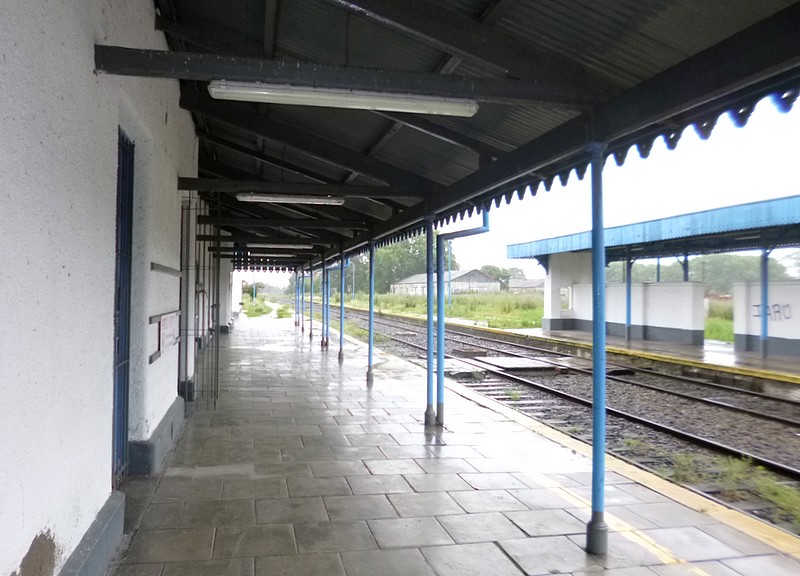
This is the southern (down) platform at Chacabuco in Buenos Aires Province (there's another Chacabuco in the Atacama desert). It is kept in good shape because the broad-gauge line (5ft 6in) still operates passenger services from Buenos Aires to Junin, which is less than a quarter of the distance it used to cover.

Standing back a bit but looking in the same direction, you can see that double tracks are in use in this station, which is pretty unusual in this part of the world where trains are few and far between. Even here there is only one daily passenger train in each direction, 6 days per week, although there may also be freight services. Trains leave Buenos Aires at 1800 and arrive at Chacabuco at 2204. In the other direction you need get on board at 0327 to catch the service to Buenos Aires arriving at 0800. The single fare is the equivalent of about £3.
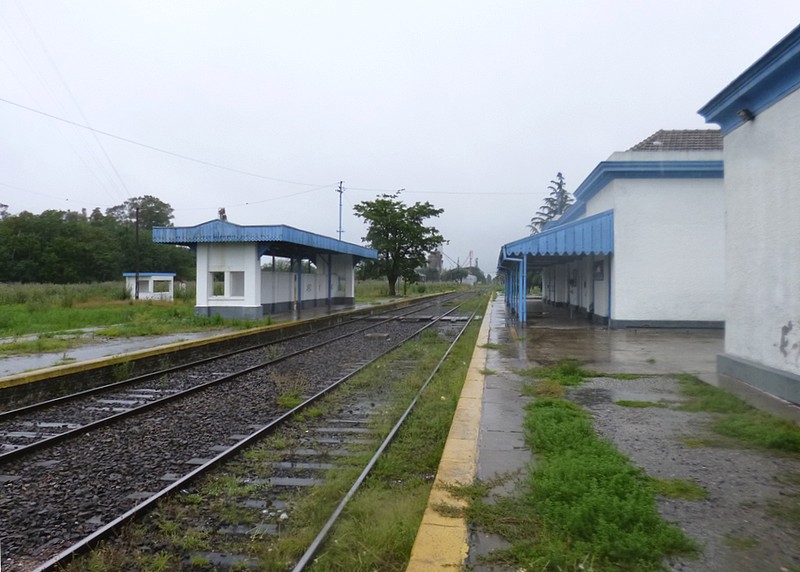
Looking the other way, with the Up platform on the left. The Buenos Aires & Pacific Railway ran through Chacabuco, onwards to Mendoza and, eventually to the Pacific port of Valparaiso in Chile. It was opened in 1886 and originally only had two stops - and Chacabuco wasn't one of them!
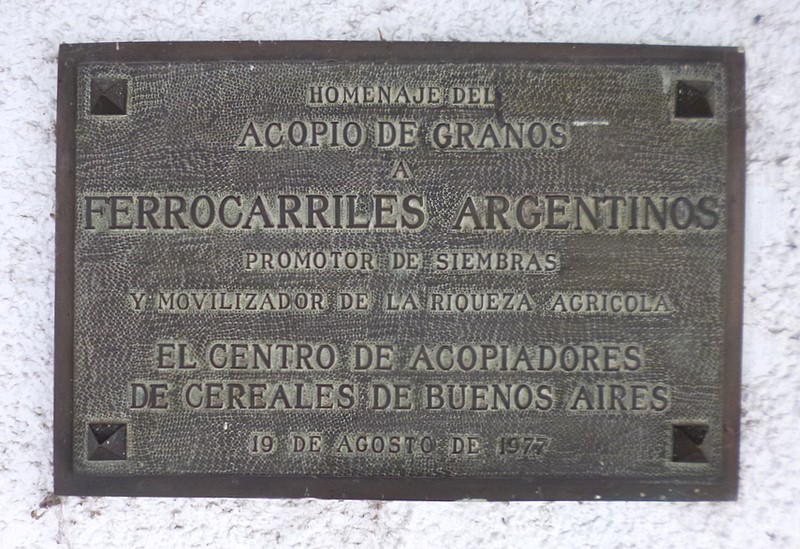
This plaque on the platform says (roughly) "In tribute of the collection of grain on Argentine railways, promoter of planting and mobilizer of agricultural wealth. The center of cereal collectors, Buenos Aires. 19 August 1977". This indicates the historical importance of the grain industry in the area, and the reason why there were so many railway lines built in this fertile region.

Here is the ticket office, which probably dates back to the very early days. The mural on the wall shows the signal box by the road crossing at the east end of the station...

... and here is that signal box today, evidently out of use and slowly falling apart.
CHIVILCOY SUD

Chivilcoy Sud (Chivilcoy South, there was once a small branch to a terminus at Chivilcoy North) is on the metre-gauge former Buenos Aires Western Railway which stretched 900km out to La Pampa province and the foot of the Andes mountains. It was the first railway in Argentina and opened in 1857, but was nationalised in 1948 and became part of the FCGSM (Ferrocarril General Manuel Belgrano Railway). Here we see my guide and translator Diego approaching the policeman by the door to see if we can get into the station and look around.
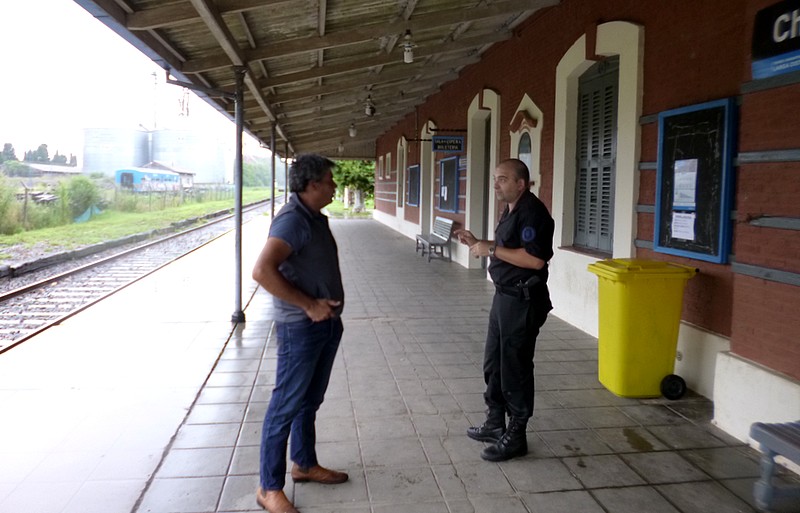
The policeman was very accommodating, and welcomed us aboard. He seemed quite happy to talk to someone, as the local force appear to guard the place 24 hours a day for only four trains per week! It must be a boring task.

And this timetable tells the story. This once proud line has now been reduced to around one quarter of its former length, and just runs from Once (an 1882 railway terminus in central Buenos Aires) to Bragado, four stations up the line from Chivilcoy. In case you can't read it, here is a resume of the service:
Yes, there's a service through this station at 0305 in the morning on a Monday! We asked the policeman why they ran it at such a crazy time, but he said it was very popular. When we asked why, he said "Because there aren't any other trains!" And I suppose it does give you a full day in Buenos Aires every Monday, although it would be a very long day! Of course another reason for its popularity might be because the single fare is only £2 in First Class (Pullman) - which isn't bad for a four-hour journey.

This view is looking north-west, towards Buenos Aires. Only one platform and a single line are in use, but the grain silos on the south side (of which there are over 50) indicate a more lucrative business for the railway.

Looking in the opposite direction towards Bragado. On the left there used to be a lot more sidings and the trees hide many more grain silos and earlier warehouses.
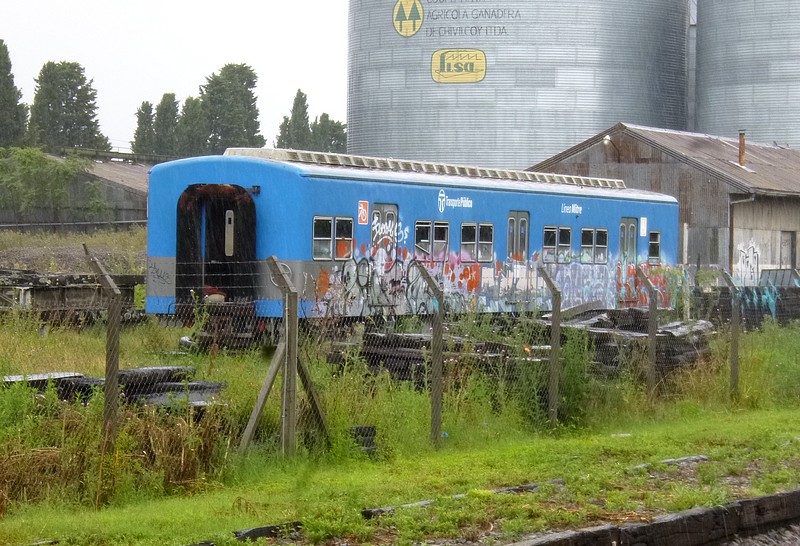
This lonely carriage abandoned to graffiti artists in a siding is marked Transporte Publico and Linea Mitre (Mitre Line) which refers to a network of broad-gauge commuter lines running out of Buenos Aires and named after a former Argentine president. It was rolling stock of this type which was involved in a tragic accident at Once station in 2012 when a train's brakes failed and it ran into the buffers, killing over 50 and injuring 700. Even though the train was only travelling at 16 m. p. h., the damage was enormous.

This plaque says (roughly) "Municipality of Chivilcoy. In tribute to Chivilcoy Sud Station on its centenary, for your invaluable service and progress for our community. 1910 - February - 2010. Prof Anibal Pittelli, Town Mayor." You have to admit that the nation seems to have really appreciated the contribution made by the railways, and that makes it all the more surprising that most of them have been closed. I guess it's all about money...
GOBERNADOR UGARTE

Now we are at the small station of Gobernador Ugarte on a short branch of the Buenos Aires Western Railway which used to serve a handful of agricultural communities in the area. Land was donated in 1908 by Indalecio Frede de Molina for the building of a town and a railway station. It was named after Gobernador (Governor) Marcelino Ugarte (1855-1929) who twice served as governor of Buenos Aires Province.
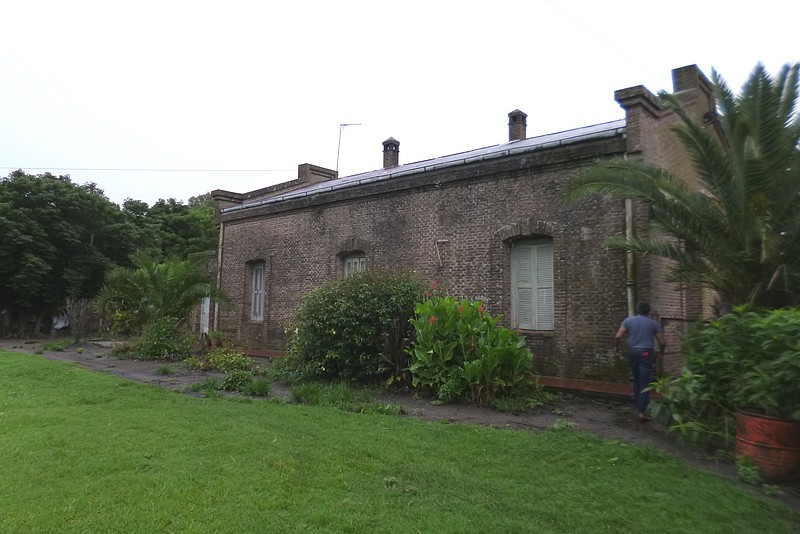
With the station building now a private house, Diego and I tried to find someone to give us permission to look around, but all we found were a couple of dogs who were surprisingly friendly - so we looked around anyway.

Here is the minimal platform (and one of the friendly dogs) looking southwest towards the end of the line at Anderson, two stations and about 15 km away. Anderson may not sound like an Argentinean name, but it's not uncommon to find towns named after British or American people - Henry Bell, Lincoln, O'Brien, O'Higgins, Morse, Warnes, Rawson, Gowland, Charles Newton, Kenny, Abbott, Giles, Roberts, Drysdale and so on...
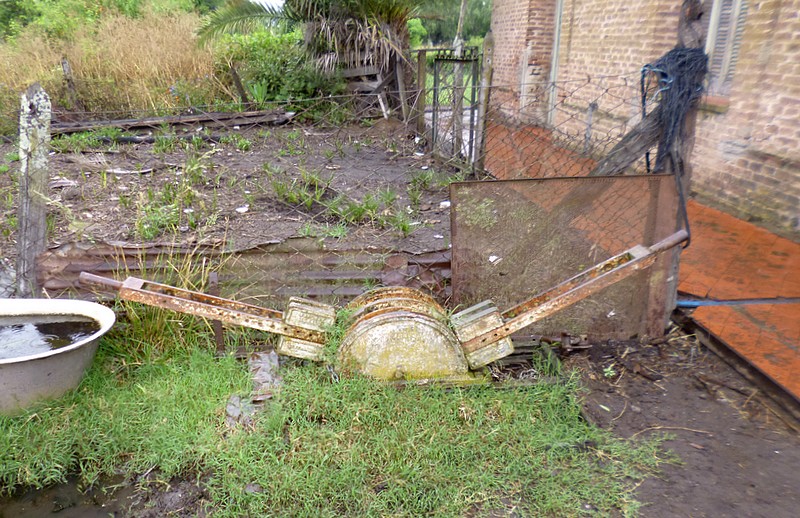
Limited passenger facilities are not surprising for a town with a population of only around 500, but the more important facilities were warehousing for grain and other agricultural produce. There are still six or seven abandoned sheds (some very large) and few old silos on the other side of the line, with traces of several sidings although no track remained anywhere. These levers on the platform, marked Railway Signal Co, Liverpool may be related to points for those sidings.
ISLAS
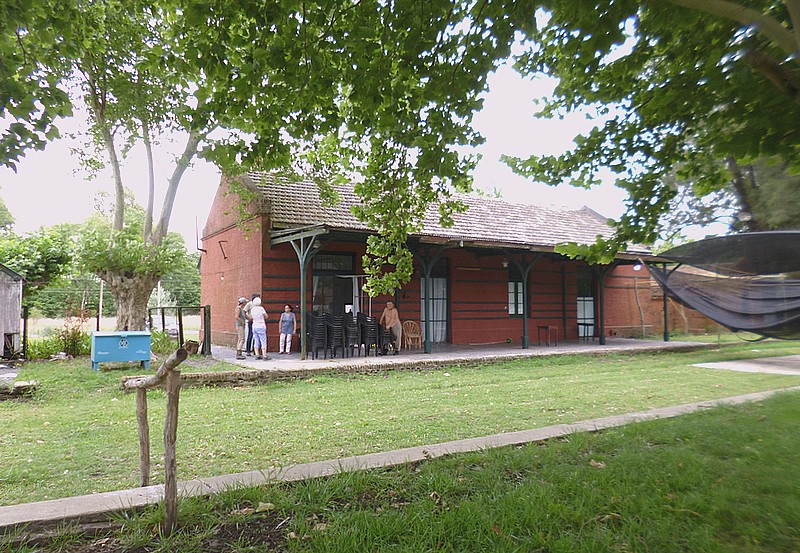
Islas (closed since 2010) is a station on the Great Southern Railway, later renamed the General Roca Railway. It is on the same line as the town where we were staying - Veinticinco de Mayo - and is named after the former owner and donor of the land in 1908, Antonio Maria Islas, local landowner and military officer. The station is now a cultural centre, and a music and craft festival is held there every March. The net on the right is to provide shade. The occupants are giving our little visiting family group a history of the place on the main platform.

Building of the station started in 1889 and it was opened in 1903. The town reached its peak in the 1940s when there were stores, blacksmiths, shops and the San Jose sports club. But the town declined and by 2000 there were almost no students at the school and it was closed. For music shows, the performers use this platform as a stage (the guitar outline on the wall lights up at night!) and the audience is seated on the opposite, main platform.
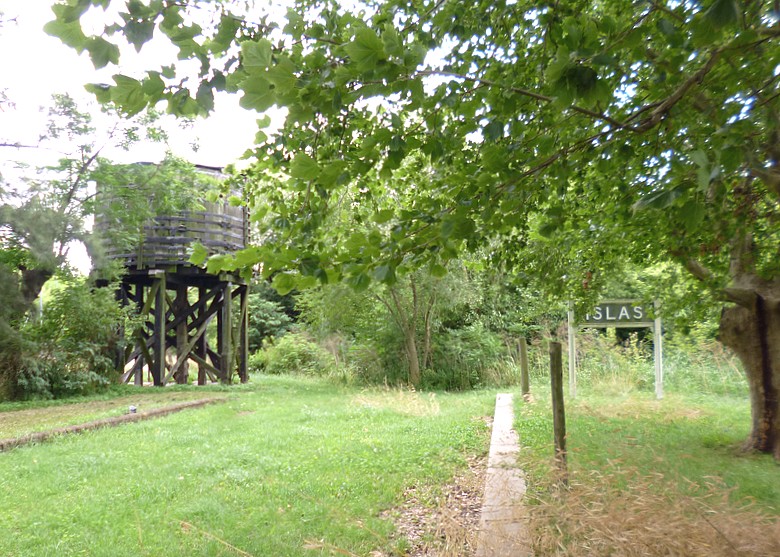
At the end of the main platform is this wonderful wooden-clad water tank for refilling steam locos. Only two wooden tanks were built on the line, and it is said that Islas was chosen because the quality of the water there was considered to be particularly good.
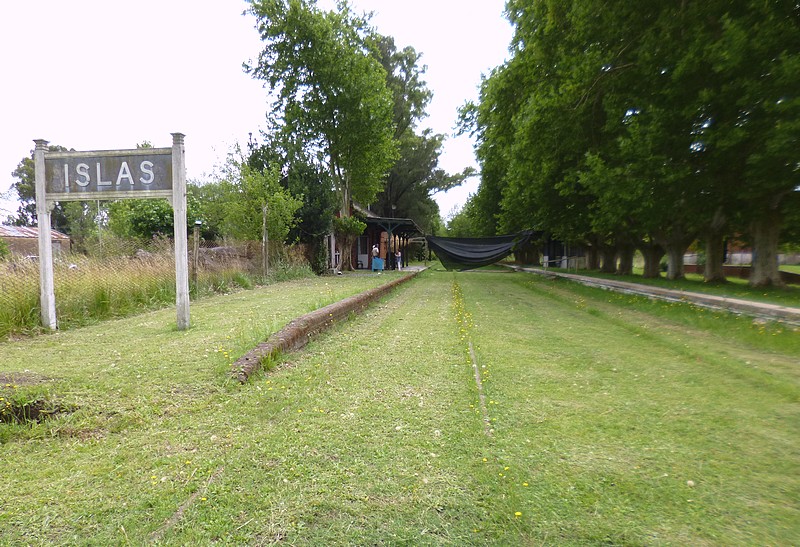
Here is the approach to Islas station, looking north east towards Veinticinco and (ultimately) Buenos Aires. Rails can just be found through the grass and overall the station is in very good condition, considering that it is nearly 120 years old and has been disused for a decade.
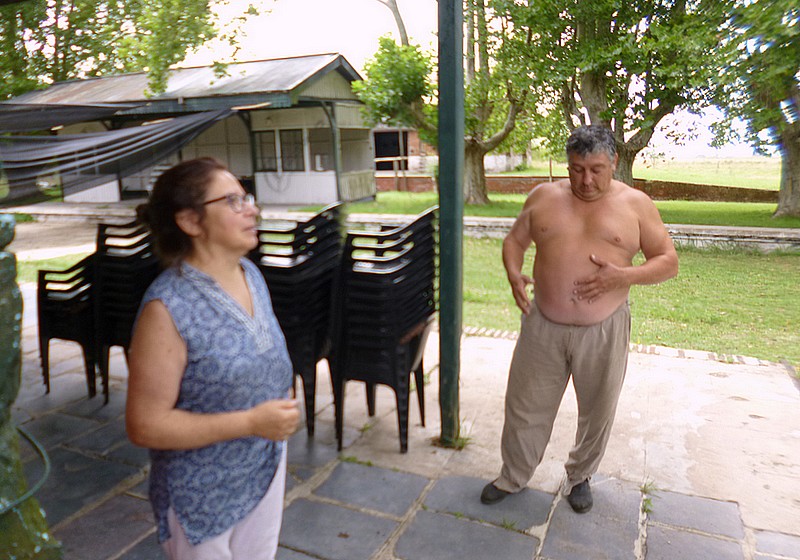
Elba Rocco and Gustavo live at Islas station and look after its welfare. They made us very welcome (even fed us with empenadas!), knew all about its history and I thank them very much for their kind hospitality.
VEINTICINCO DE MAYO

Finally a brief revisit to the large disused station and maintenance facility at Veinticinco de Mayo. Chris Capewell was interested to know more about the smaller steam crane that I had noted on my previous visit in 2018. This time I was able to find some serial numbers and take better pictures, which enabled Chris to identify it as an Orenstein and Koppel from Spandau, Germany.
Chris said "A similar machine is preserved at Comodoro Rivadavia. Several small cranes went to Argentina from this manufacturer, though they are often credited to A. Koppel, or Humboldt. I think both were acting as agents." Chris's colleague Rob Dickinson runs a huge website about international steam with an amazingly comprehensive section on steam cranes which is well worth a visit. My thanks to Chris and Rob for their help.

Things are slowly deteriorating in the old railway maintenance area at Veinticinco, and this former workshop is exposed to the elements. I guess it won't be long before all this stuff is pulled down.
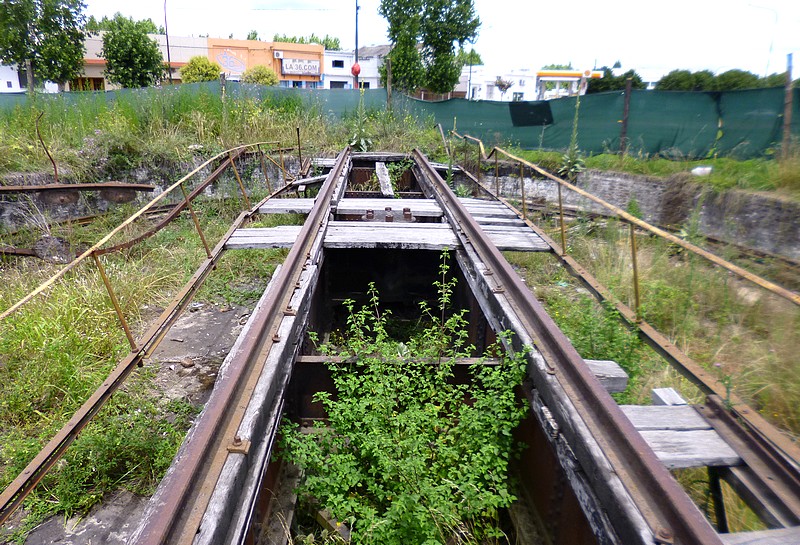
When I visited in 2018 you could spin this turntable by hand, but on this trip I found it surrounded by a netting fence, presumably to keep people out because it's now in a dangerous condition. Bits are falling off everywhere, it doesn't turn any more and the weeds are taking over. Although I couldn't find any plates or serial numbers to identify the manufacturer, there were marks where it looked as though plates with angled corners had been removed. Chris Capewell (see the caption to the steam crane picture above) said "the table looks to be a Ransomes and Rapier under-girder type - their worksplate typically had scalloped corners".
That's all for now. It was a fascinating look around the area, and there's still lots more to see. I guess it should be recorded before it all finally fades away.
Email Events diary Past events list Classified adverts Classic U.K. Buses Classic Irish Buses Classic Manx Buses